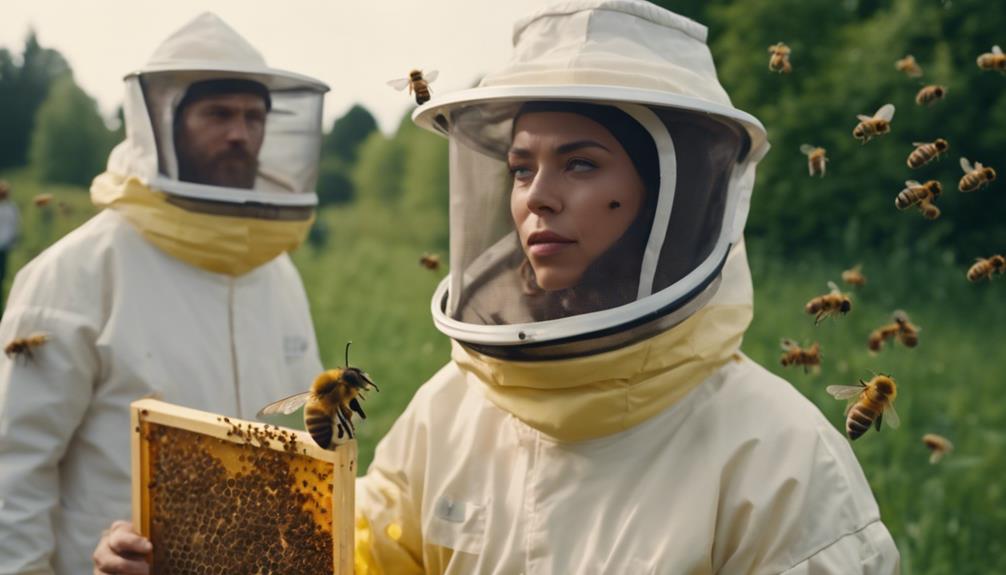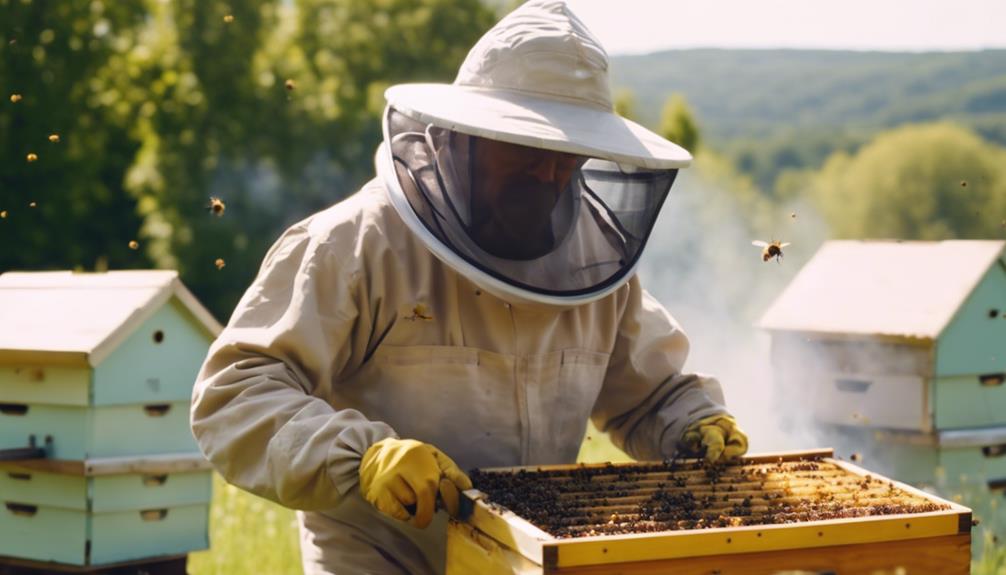We still use smoke to calm bees when working with honeybee colonies. It’s a technique that dates back to Indigenous Native Americans who discovered that smoke could soothe bees before the invention of bee smokers in the 19th century. The smoke actually anesthetizes the bees, making beekeeping safer and more manageable. While alternatives like essential oils and air purifiers exist, modern beekeepers continue to rely on smoke as a valuable tool for hive management, emphasizing its strategic use. Remember, there’s a whole world of beekeeping practices and ethical considerations waiting to be discovered beyond just bee smoking!
Main Points
- Beekeepers still use smoke strategically for safer hive interactions.
- Alternatives like air purifiers and essential oils offer gentle bee calming.
- Modern practices prioritize bee welfare and stress reduction.
- Ethical considerations focus on minimizing stress and harm during smoking.
- Future trends aim for sustainable and eco-friendly beekeeping methods.
Origins of Bee Smoking
The origins of bee smoking predate the invention of the bee smoker, with Indigenous Native Americans using smoke to calm honeybees before the modern device existed. This fascinating practice goes way back in beekeeping history. Imagine those early beekeepers, like a bee whisperer with a puff of smoke!
It wasn’t until Moses Quinby came along in 1873 that the first official bee smoker was created. Tracy F. Bingham later improved and patented this essential tool in 1903. The bee smoker invention transformed beekeeping practices, making it safer and more efficient.
It’s intriguing how something as simple as smoke could anesthetize honeybees, allowing beekeepers to work their magic without getting stung. The bee smoker origins truly highlight the ingenuity of our predecessors.
Impact on Bee Behavior
Pivoting from the origins of bee smoking, the impact of smoke on bee behavior is noteworthy. When we light that smoker, the smoke masks their alarm pheromones, leading to a reduction in defensive behavior. It’s captivating how bees react – they start consuming honey, almost as if they’re gearing up for a potential hive relocation.
However, it’s essential to note that smoking bees in established hives is pretty much ineffective; these bees are staying put. Surprisingly, swarms tend to be less defensive, sometimes not even requiring smoke for handling. But be cautious when smoking bees in swarms, as it can complicate extraction processes.
The use of smoke certainly has a notable impact on bee behavior, influencing how they interact within their hives and swarms.
Alternatives to Smoking Bees
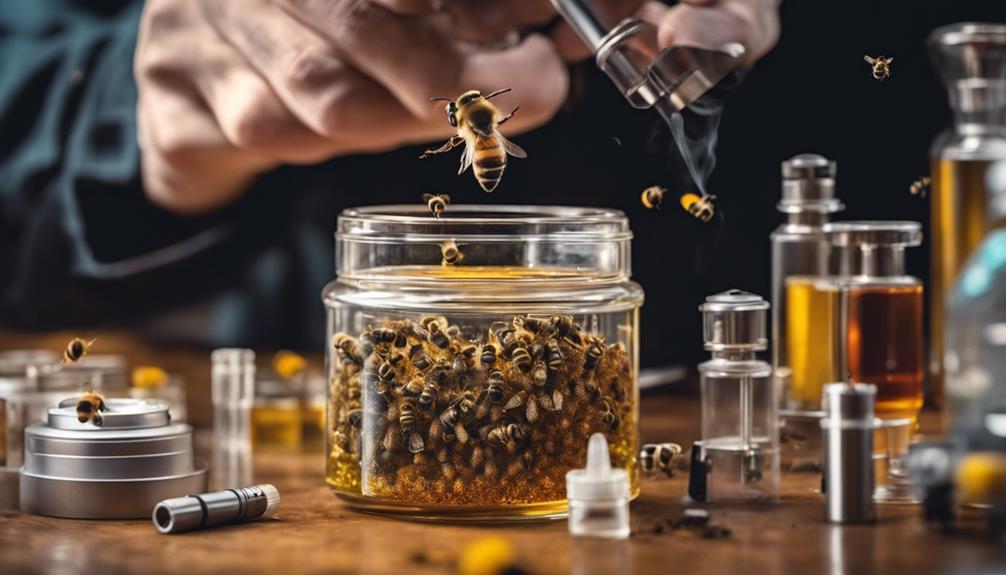
We’ve all heard of smoking bees to keep them calm, but did you know there are bee-friendly alternatives out there?
Beehive air purifiers, bee-friendly essential oils, and herbal calming methods are gaining popularity in the beekeeping world.
These alternatives offer effective ways to calm bees without the traditional use of smoke, providing a more natural and gentle approach to bee management.
Beehive Air Purifiers
Opting for beehive air purifiers presents beekeepers with a gentle and effective alternative to the traditional method of smoking bees during hive inspections. These devices release a calming pheromone, along with essential oils and natural compounds, to mimic the soothing effects of smoke without the actual smoke.
The use of beehive air purifiers offers a safe and non-invasive approach to hive management, ensuring the well-being of both bees and beekeepers. As these purifiers gain popularity among beekeepers seeking a more gentle way to work with their bees, they prove to be a valuable tool in maintaining a harmonious relationship with our buzzing friends.
The calming nature of these devices makes hive inspections a breeze, allowing us to tend to our hives with ease and tranquility.
Bee-Friendly Essential Oils
Exploring bee-friendly essential oils as alternatives to smoking bees reveals a natural and effective approach to improving and managing bee behavior in hive inspections. Bee-friendly essential oils like lemongrass, lavender, and spearmint can calm bees, mask alarm pheromones, and promote a positive environment, reducing stress for both bees and beekeepers.
By incorporating these natural essences, we can create a non-invasive way to manage bee behavior while fostering a sustainable and environmentally friendly beekeeping practice. Using essential oil sprays on hands and clothing before approaching the hive can help establish a peaceful atmosphere, avoiding the potential risks associated with traditional smoking methods.
Embracing these aromatic allies not only benefits the bees but also enriches our beekeeping experience with a gentle touch.
Herbal Bee Calming Methods
Incorporating herbal bee calming methods as an alternative to smoking bees offers a natural and effective way to soothe bee behavior during hive inspections. Here are four ways these herbal methods can help:
- Popular Herbs: Lavender, chamomile, and lemongrass are well-loved for their calming properties, making them excellent choices for calming bees.
- DIY Herbal Sprays: Crafting herbal sprays or sachets with these herbs can provide a gentle and soothing aroma for the bees.
- Natural Soothing: Herbal calming methods work with the bees’ natural instincts, promoting a relaxed environment within the hive.
- Avoiding Smoke Exposure: Some beekeepers opt for herbal methods to steer clear of smoke exposure for both the bees and themselves, creating a more pleasant beekeeping experience.
Modern Beekeeping Practices

In modern beekeeping practices, hive management techniques have advanced significantly.
Honey production methods now incorporate innovative technology for efficiency and quality.
Pest control strategies have also evolved to guarantee the health and well-being of bee colonies.
Hive Management Techniques
We utilize smoke in modern beekeeping practices to effectively calm bees during hive inspections and manipulations, ensuring safer interactions with honeybee colonies.
Here are four key points about hive management techniques in contemporary beekeeping:
- Strategic Use: Beekeepers strategically apply smoke to manage bee behavior and minimize defensive responses, allowing for smoother hive inspections.
- Advancement of Practices: With advancements in equipment and techniques, the use of smoke in beekeeping has evolved to improve efficiency and effectiveness in hive management.
- Continued Reliance: Despite modernization, beekeepers still rely on smoke as a valuable tool to facilitate easier and safer interactions with honeybee colonies.
- Best Results: Modern hive management techniques stress the importance of judiciously using smoke for best outcomes in beekeeping practices.
Honey Production Methods
Utilizing gentle hive management techniques has become a cornerstone of modern beekeeping practices, emphasizing the well-being of bees during honey production. Nowadays, beekeepers are shifting towards methods that reduce stress on the bees, such as using bee escape boards and queen excluders. These tools aid in harvesting honey without the need for smoke, promoting sustainable honey production.
Some beekeepers even opt for smokeless beekeeping to maintain the quality and purity of the honey. This shift not only safeguards bee health but also guarantees a more sustainable approach to honey production. By prioritizing stress reduction and bee welfare, modern beekeeping practices are evolving to create a more harmonious environment for both bees and beekeepers alike.
Pest Control Strategies
Implementing Integrated Pest Management (IPM) techniques is essential in modern beekeeping practices to minimize the reliance on chemical pesticides and maintain hive health.
Here are some strategies we use for pest control in our beehives:
- Screened Bottom Boards: These help in monitoring and controlling Varroa mites by providing a way for them to fall off the hive.
- Drone Brood Removal: By removing drone brood, we disrupt the Varroa mites’ breeding cycle.
- Essential Oils: Natural alternatives like thymol and menthol are effective in controlling pests without harming the bees.
- Sticky Boards: These boards help us gauge pest levels in the hive, guiding our pest control decisions.
Ethical Considerations in Bee Smoking
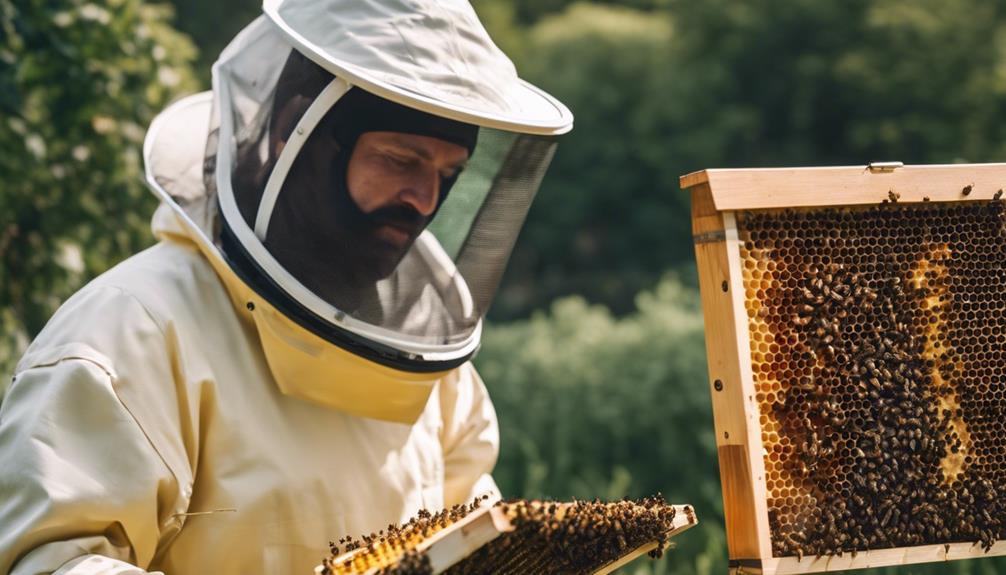
When considering ethical bee smoking practices, prioritizing the well-being of honey bees is vital. Ethical beekeepers understand the importance of minimizing stress and harm to bees during hive inspections. Using smoke judiciously is essential to reducing stress levels while ensuring proper ventilation and monitoring smoke exposure.
Excessive smoke can have negative effects on bee health and behavior, so it’s important to be mindful of the impact. By practicing sustainable beekeeping methods and being aware of the effects of smoke on bees, we can promote a healthy environment for our buzzing friends. Remember, a little smoke goes a long way in calming bees without causing harm.
Let’s aim for ethical bee smoking practices that prioritize bee health and well-being.
Educational Campaigns on Bee Health
As we explore Educational Campaigns on Bee Health, our focus shifts towards advocating for sustainable beekeeping practices. Here are four key aspects to ponder:
- Ecosystem Importance: Educational campaigns highlight the vital role bees play in maintaining the balance of our ecosystems.
- Protect Bees: These initiatives educate on ways to safeguard bees from harmful factors like pesticides and habitat loss.
- Beekeepers Resources: Providing beekeepers with valuable resources and information enriches their ability to keep bee colonies healthy.
- Collaborations: Collaborations between beekeeping organizations and researchers ensure the dissemination of up-to-date and valuable knowledge on bee health.
Through these campaigns, we aim to empower beekeepers and enthusiasts with the knowledge needed to guarantee the well-being of these essential pollinators.
Future of Beekeeping Techniques
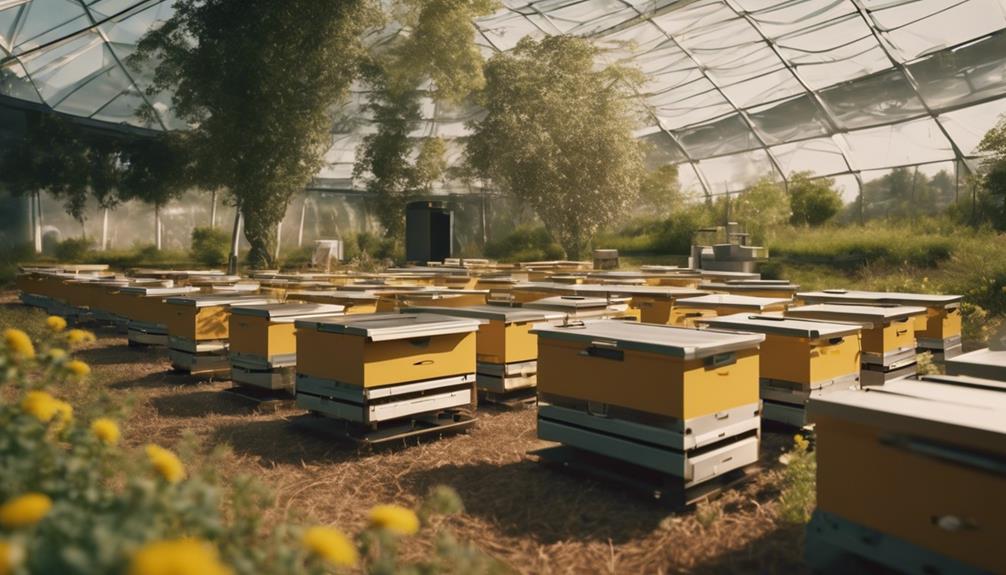
Exploring innovative and sustainable alternatives to traditional bee smokers is shaping the future of beekeeping techniques. With a focus on eco-friendly methods and advancements in technology, beekeepers are seeking new ways to calm bees without smoke.
Research into bee behavior is providing valuable insights into alternative practices that reduce reliance on smoke, promoting a more essential relationship between beekeepers and their colonies.
Collaboration among beekeepers, scientists, and environmentalists is vital in driving the adoption of smoke-free beekeeping practices. By embracing these innovative bee calming methods, the future of beekeeping looks promising, with a shift towards more sustainable and bee-friendly practices.
Together, we can pave the way for a future where beekeeping isn’t only productive but also in harmony with nature.

Hello! My name is Noel Calvin. I graduated from UCLA and now work as a writer at Launch Ninjas. I write blog posts that inspire and guide our readers in their entrepreneurial pursuits. I live in Pleasantville, NJ, with a peaceful yet lively atmosphere that inspires me.
Writing stories is more than just a job for me. It allows me to share my observations and satisfy my curiosity about the world. I combine my analytical skills with creative enthusiasm to delve into technology trends and startup stories. But my life isn’t limited to screens and keyboards. I value loyalty, passion, and a touch of old-fashioned charm, which I infuse into every narrative I create.
I love spending time in my garage, jamming with my band when I’m not writing. Playing the guitar and singing bring me immense joy. I also enjoy capturing ordinary and extraordinary moments through my camera lens and exploring new culinary adventures that excite my taste buds. I’m always seeking new experiences.
My family is very important to me. Joyful Sunday brunches filled with laughter and intense board game nights keep me grounded, reminding me of life’s simple pleasures.
In my world, every moment is an opportunity for discovery. Every discovery is a story worth sharing, whether a heartfelt moment at home or the pulse of technological innovations. Join me as I navigate through life, one blog post, one guitar strum, and one heartwarming family dinner at a time.
